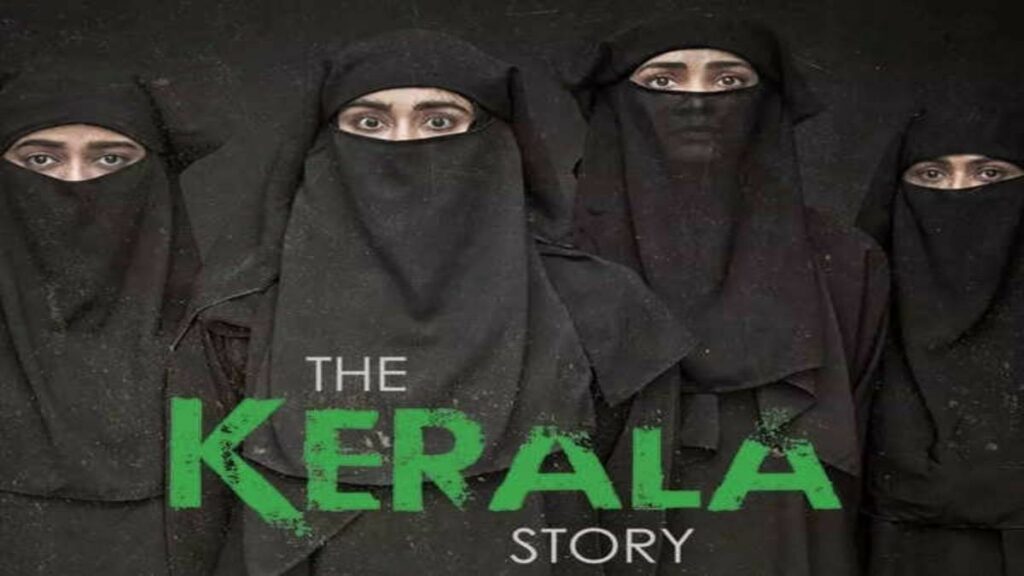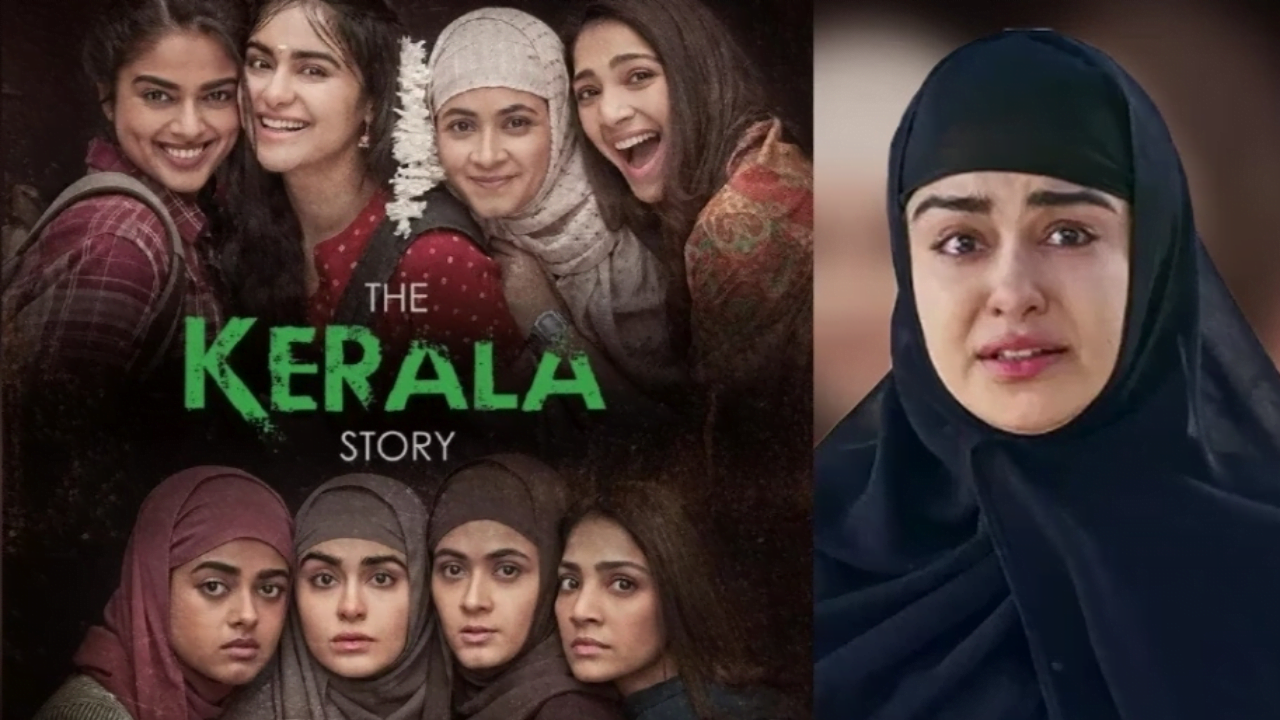Spoiler alert: This is a review of the film ‘The Kerala Story’.
“Ek seedhi saadhi nursing student ko kaise suicide bomber banata hai” (How is a nursing student moulded to be a suicide bomber) the protagonist of the film The Kerala Story, Shalini (Adah Sharma) who converted to be Fatima and was travelling to Syria to join ISIS says with teary eyes before she shares her story with the Afghan security officials sitting in the UN Incarceration centre. She says it’s not just her’s but 30,000 girls from Kerala who have gone missing in Afghanistan, Yemen and Syria. The subject demands a sensitive and critical understanding of the social fabric and how women manoeuvre it. But, the way director Sudipto Sen and producer Vipul Shah have approached the subject is contentious if not ridiculous.
A muddled plot in fictional geography: The Kerala Story
The Kerala story tells the tale of 3 young girls from Kerala targeted by an unlawful terror outfit, persuading them to convert to Islam and join them with arms to fight for establishing an Islamic caliphate. The story follows Shalini Unnikrishnan who meets Geetanjali, Nimah and Asifa as her fellow roommates once she moves to Kasaragod for her nursing studies. Just like any other Muslim character portrayed in propaganda films, Asifa has only one goal and that is to convert these 3 girls.
Director Sudipto Sen claims that the movie is the product of his extensive research on the issue of conversion and trafficking done by terror outfits. In fact, this is his second creation addressing the issue, the first was a documentary titled ‘In The Name Of Love – Melancholy Of God’s Own Country’ released in 2021. The search for this lead me to an article by him in Firstpost in which he explains how he was petrified to see villages in Malappuram following the Sharia law. But two years later, when his “fact” was included in the movie, it was Kasaragod which has villages with Sharia law.
She introduces them to her cousin Ramiz and his friends who are tasked to convert them in the pretext of love. The local Islamic centre acts as their mission headquarters and the priests there are their mission commanders. While Shalini falls “prey” to their sinister plan and soon finds herself in Afghanistan with her husband, the other two resists and have to pay a price for it. The story is told through the eyes of Shalini at the UN incarceration centre in Afghanistan.

Director Sudipto Sen claims that the movie is the product of his extensive research on the issue of conversion and trafficking done by terror outfits. In fact, this is his second creation addressing the issue, the first was a documentary titled ‘In The Name Of Love – Melancholy Of God’s Own Country’ released in 2021. The search for this lead me to an article by him in Firstpost in which he explains how he was petrified to see villages in Malappuram following the Sharia law. But two years later, when his “fact” was included in the movie, it was Kasaragod which has villages with Sharia law.
Being from Malappuram, it was obvious to think of where are these villages in Malappuram that I could never see. The Malappuram that I’m used to is the one in which Hindu-Muslim unity and solidarity are stronger and communities celebrate together irrespective of what religion they practise. But to give the director a fair chance, I will inconveniently forget that I am from Kerala and that too from Malappuram.
Being from Malappuram, it was obvious to think of where are these villages in Malappuram that I could never see. The Malappuram that I’m used to is the one in which Hindu-Muslim unity and solidarity are stronger and communities celebrate together irrespective of what religion they practise. But to give the director a fair chance, I will inconveniently forget that I am from Kerala and that too from Malappuram.
It would be normal for anyone to assume that a movie titled The Kerala Story would put some effort into showing the state in its true essence. However, barring the few shots of Kathakali and backwaters that flashes during a song, the maker’s portrayal of Kerala would leave even the natives feeling alienated from their state.
Also Read: Extrapolated Numbers, Manipulated Facts, And Hysteric Dialogues In The Kerala Story
Despite the language of the movie being Hindi, it remains a mystery why did the director force the non-native cast to occasionally rumble a few Malayalam words here and there. While Adah Sharma who plays the lead character Shalini Unnikrishnan struggled to pronounce Thiruvananthapuram, the district where her character is from, the performance of others with their Malayalam portion sounded equally incongruous.
Portrayal of women, Muslims and the authenticity of director’s research
Everyone has the right to tell or narrate stories in the manner that they deem pleasing. However, if you claim that the story you are sharing is of 30,000 women, you should give your characters a basic level of intellect unless you want to tell them that you are blatantly sexist. The movie has a fair share of monotonous monologues by Asifa questioning the legitimacy of Hindu gods, justifying Allah is the true god and all Kaafirs (Non-believers) are going to hell which is 70 times hotter than worldly fire.
Though the movie shows that Shalini comes from a practising Hindu family and Geetanjali from a staunch communist background, not even once do they find a reason to put up a strong debate against Asifa’s ridiculous arguments, instead, they fall for her lectures. Throughout the movie, it is portrayed through the lead characters that the Hindu women are extremely vulnerable and are prone to fall for the traps of anyone who shows them little care and affection.
Had he spent the time that he claims to have spent in Kerala, Sudipto Sen would have known that the Pathani suit is not a common wear among the Kerala Muslim men, or that the Muslim grooms in Kerala don’t wear a sehra (A headdress that is commonly worn by the grooms in north-India), or the ijabo qubool, which is not a practice that Muslims in Kerala are aware of. The Muslims in The Kerala Story don’t stop at being shady but transgress into the territory of evil with everyone having terror links and one agenda, that is to convert all Hindu girls to become suicide bombers.
Had he spent the time that he claims to have spent in Kerala, Sudipto Sen would have known that the Pathani suit is not a common wear among the Kerala Muslim men, or that the Muslim grooms in Kerala don’t wear a sehra (A headdress that is commonly worn by the grooms in north-India), or the ijabo qubool, which is not a practice that Muslims in Kerala are aware of. The Muslim characters in The Kerala Story don’t stop at being shady but transgress into the territory of evil with everyone having terror links and one agenda, which is to convert all Hindu girls to become suicide bombers.
Bollywood usually follows a good-Muslim bad-Muslim narrative, a Muslim man or woman as a flag bearer of secularism and patriotism to give a speech to the terrorists on who is a ‘true or good Muslim’. But in this movie, there are no binaries and good Muslims do not exist!
A film isn’t the ideal space to debunk facts and figures, but The Kerala Story rides on the isolated experiences of 3 women and magnifies to show it as a universal fact, hence it calls for a fact-check. The movie claims that there are over 30,000 women who are converted to Islam but this is actually an inflated figure based on a statement by Oommen Chandy in the year 2012, who was the then chief minister of Kerala. He submitted in the state legislature that around 2800 women are converted to Islam from the period of 2006 to 2012. The director then calculated the data for 10 years taking the given number as a yearly count of conversions.
Also Read: ‘The Kashmir Files’: India’s ‘Schindler’s List’ Or Right-Wing Extremist Propaganda?
Apparently, Sudipto Sen thought that statistical data can be calculated the way it pleases him. According to the same report, there is no proof of forced conversions in the state or of the mass missing of girls who have joined ISIS and have gone to Syria, Yemen or Afghanistan. In fact, if we consider recent data, the major share of conversions are happening from other religions to Hinduism. It is interesting to note that now the makers of the film are saying the number is not 32,000 but 3.
The message and the target audience
Apart from the subject and the statistics, is this a good movie? Sadly, the answer is no. In terms of performance, Adah Sharma has pitched in a modest attempt to make Shalini a convincing specimen but falls short due to the limitations or the atrocity of the screenplay. The screenplay tends to rely on amplification of shock and sorrow and the way the cast has delivered it surely will take the attention away from the screen. The non-linear narrative of storytelling from Shalini’s point of view could not be stitched well that the movie-watching experience feels more like a ride on a bumpy road, jolty. The obvious background scores make the experience often weary.
Makers haven’t even left room for the audience to make their own assumptions, everything is spoon-fed since the beginning of the movie. The film has ample close-up shots of lead characters with tears gushing out saying ‘We were brainwashed’ or how they were groomed to be suicide bombers. However, the reality is that The Kerala Story will still be a success and that is because the target audience of this movie is not those who know about Kerala or those who know Kerala Muslims.
The question of whether this movie is propaganda has no scope since the movie makes it evident with all the tropes. Shalini and her husband are advised by their handler in Afghanistan to say that they are with ‘Amnesty International’ when they cross the checkpoint. In another instance, Geetanjali’s character tells her father how he had time to learn ‘communism’ which is a foreign ideology but never found the time to teach her Hinduism.

Makers haven’t even left room for the audience to make their own assumptions, everything is spoon-fed since the beginning of the movie. The film has ample close-up shots of lead characters with tears gushing out saying ‘We were brainwashed’ or how they were groomed to be suicide bombers. However, the reality is that The Kerala Story will still be a success and that is because the target audience of this movie is not those who know about Kerala or those who know Kerala Muslims. It targets those who have heard “stories” of Hindu suffering and Islamic terrorism in the state. For them, this movie is enough proof that those stories were real.
Sitting at a theatre in Gurugram, I asked a lady sitting next to me about how she is finding it, to which she replied, “I mean, this is the reality right?” and that is the success of this movie.





